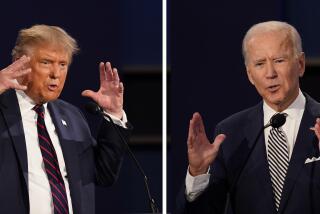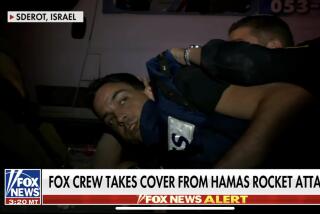Networks jockey for clear shot at war
- Share via
NEW YORK — In the lead-up to a possible military confrontation with Iraq, network news organizations are playing their own technology cat-and-mouse game to rival the Allies shadowboxing over United Nations weapons inspectors.
In the Gulf war 12 years ago, CNN trumped its rivals with a “four-wire” connection -- a dedicated phone line that bypassed the central phone system, the only one that the Iraqi government permitted -- that gave it audio contact as Baghdad was being bombed and others lost their standard phone lines.
What one network executive calls a “quantum leap” in technology since then has led to portable satellite dishes that promise viewers a closer, clearer, more immediate video look, not just audio, at any place a reporter goes. As recently as the conflict in Afghanistan, networks were largely limited to satellite video phones with jerky images.
The technology promises a different kind of armchair access for viewers at home to follow the conflict, with ramifications for how public opinion gets shaped.
But most network executives won’t talk about the developments except in the broadest terms to avoid revealing competitive information to their rivals.
News executives also don’t know whether the U.S. military will allow use of the technology, and whether they will have permission to be in Iraq if and when combat starts.
ABC News, CNN and Fox News Channel executives said they wouldn’t discuss their technology although Ted Koppel, in a recent “Viewpoint” broadcast, referred to “little portable satellite dishes [that will] make it possible for us to go on the air live as the action is underway.”
Marcy McGinnis, CBS News senior vice president for news coverage, said broadly that “the technology is enabling us to transmit video and audio from remote locations in ways that weren’t possible before.”
But she said she “can’t talk about certain things we may have put together to give us a competitive edge.”
NBC News was more forthcoming, because its rivals can’t buy the proprietary equipment the network developed with Raytheon Corp. and Norway’s Tandberg Television.
“It’s basically a portable communications center that feeds both reasonably high-quality television pictures and also provides a path for telephones and computers,” said Bill Wheatley, NBC News vice president.
NBC contends its new system is cheaper and will allow its reporters to get on the air faster. Wheatley says the system is no bulkier than the ones some NBC rivals are using, a single-suitcase satellite uplink terminal made by Sweden’s Swe-dish Satellite Systems.
Pal Ekberg, who handles the company’s military sales, says the 75-pound package transmits broadcast-quality pictures and uses an easy-to-use computer setup. A version sold to broadcasters costs about $130,000.
The big question now is when networks will be able to use their gear. The U.S. military has reversed recent policy and said it will “embed” reporters with coalition troops, but conversations still are taking place about how much equipment TV reporters will be allowed to bring and when they will be able to use it.
Rear Adm. Stephen Pietropaoli told ABC’s “Viewpoint” that embedded TV reporters are “not going to necessarily be able to go live if a tactical situation puts troops at risk.”
But he added that live communication back to the American people also will be important because their “support for our efforts and our objectives is pretty critical to an overall success.”
Network executives insist technology is only one element of their coverage.
“Although new technology will make a big difference in coverage of this war, if it happens, we should not lose sight of the fact that superb war-time reporting is supplied not by gadgets but by top-notch, courageous journalists,” said Eason Jordan, CNN’s chief news-gathering executive, in an e-mail declining to discuss CNN’s technology.
“Technology is a tool,” Wheatley said. “You still have to be in the right place, you still have to be permitted to use it and you still need to do a good job when you use it. If you don’t know where to aim the camera and your correspondent doesn’t know what to ask then it doesn’t do any good.”
More to Read
The biggest entertainment stories
Get our big stories about Hollywood, film, television, music, arts, culture and more right in your inbox as soon as they publish.
You may occasionally receive promotional content from the Los Angeles Times.










